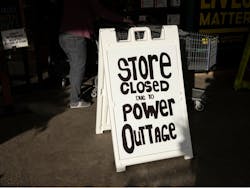California’s Community Energy Resilience Act (SB 833), which would help cities and local governments develop energy resilience plans using clean distributed energy resources, passed a key legislative hurdle this week.
The state legislative Committee on Energy, Utilities and Communications cleared the way for the bill to proceed in a unanimous vote, following statements in its favor from The Climate Center, Rural County Representatives of California and the Microgrid Resources Coalition, among others.
“We must prioritize development of clean energy sources, especially in low-income communities, so we minimize the environmental threat and keep the lights on for everyone,” said Sen. Bill Dodd, D-Napa, sponsor of the bill, following its approval.
The legislation calls for the California Energy Commission to provide technical assistance and grant programs to support local resilience plans. Grant winners would partner with utilities to identify areas most likely to experience outages and develop plans to ensure reliability at the critical facilities in those areas.
Kurt Johnson, community energy resilience director with The Climate Center, an organization sponsoring SB 833, said in testimony that while California is a global technology leader it has some of the least reliable electricity in the country.
Rural countries hard hit by power outages
“If you want to get something built, you need to have a plan. Right now, for most local governments, the plan for how to keep the lights on for critical facilities is diesel generation. California can do better,” Johnson said.
John Kennedy, policy advocate for the Rural County Representatives of California, which represents 39 rural counties, said that rural areas have been hit hard by intentional outages that utilities enacted to avert wildfires.
“Last year, there were over 600 outages related to PG&E’s deployment of its Enhanced Powerline Safety Settings (EPSS) Program, which shuts off power lines if something comes into contact with them. Most of these outages lasted for 8 hours or more and were extremely disruptive for residents, businesses, and the provision of community services. With PG&E’s expansion of these settings systemwide, we expect to see even more disruptions across the state,” Kennedy said.
He said his organization doesn’t dispute the importance of the shutoffs. “However, we note that we need to improve the existing system to minimize the impact that shutoffs have,” he said.
Kennedy also noted that power reliability will become increasingly important as the state electrifies transportation.
“We believe that SB 833 will help us improve energy reliability by helping local governments better understand how to develop solutions to meet our local needs,” he said.
The bill now heads to the Senate Appropriations Committee.
Demand response bill
In addition to clearing the way for SB 833, the committee approved another bill, SB 839, which strengthens a state regulatory mandate to call for emergency demand response during peak demand and requires participation from the state’s three largest utilities.
Dodd, who also sponsored the demand response bill, says it would help prevent rolling blackouts in the state.
Track news about microgrid-related legislation. Subscribe to the free Microgrid Knowledge Newsletter.







